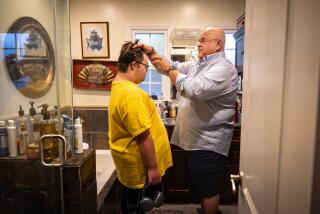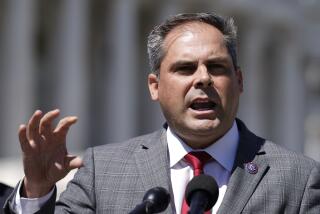Advisory Panel Bemoans Lack of Funding for Cancer Research : Medicine: Belt-tightening has cut money supply and forced a variety of programs to vie for a limited pot.
WASHINGTON — At the close of one of his last meetings as chairman of the National Cancer Advisory Board, Dr. David Korn recalls the exasperation he and his colleagues on the panel felt about the limited amount of funding available for cancer research. The board, which advises the National Cancer Institute on how to use its resources, was stymied by the small amount of money available for an array of worthy research proposals.
“We should probably change the name of the national cancer program to the National Cancer Savings and Loan Program,” Korn said. “That would make us eligible for billions of dollars in bailout funds.”
It was an old lament: The government can find billions to save the floundering savings and loan industry but nothing more for health--or substitute any domestic program for health. All have been hard hit by the federal belt-tightening of the 1980s.
But the austerity seems to have had an especially dramatic impact in cancer spending--perhaps because few diseases strike the same level of terror as cancer. It is perhaps the diagnosis that Americans fear the most.
“There is something especially fearsome about cancer,” Korn said.
A recent poll of 1,004 Americans by the National Center for Health Statistics showed that 44% believe that cancer should be the government’s top disease research priority, compared to 35% for AIDS, 13% for heart disease--which actually claims many more lives than cancer--and 6% for Alzheimer’s disease.
“Forty-four percent of the populace is answering cancer, yet the funding of cancer is not commensurate with the interest of the American public or the urgency of the problem,” said Dr. John Laszlo, senior vice president of research for the American Cancer Society.
The National Cancer Institute, the federal government’s lead research agency for cancer, received large increases during the 1970s after its inception, but the pace of its funding has slowed considerably since 1980. Modest increases during the last 10 years have failed to keep pace with inflation. Measured in 1980 constant dollars--that is, 1980 buying power--institute funding has dropped more than 6%.
“We’re the only institute that has had such a decline,” said Dr. Samuel Broder, director of the cancer institute. Moreover, he said, certain programs--including institute-sponsored clinical trials and its prevention and control program--have fallen by one-third, also when measured in constant dollars.
To a large extent, what has happened to cancer funding is a reflection of the current budgetary restraints, which do not allow money to be shifted among defense, international and domestic spending. As a result, numerous domestic programs have been forced to vie for chunks of a limited pot.
“We don’t act in a vacuum in the Congress,” said Rep. Henry A. Waxman (D-Los Angeles), chairman of the House Energy and Commerce subcommittee on health. “This year, under the latest budget agreement, we’re even further boxed in by rules that would keep us from reaching some of the peace dividend we hope to see from the end of the Cold War. But in order to increase spending for cancer research, we would have to take it away from other research activities, and other important health and domestic programs which are also underfunded.”
Iowa Sen. Tom Harkin, a recently declared Democratic presidential hopeful, tried to move a proposal through the Senate that would transfer $3.1 billion from the Pentagon budget to expand health, education and low-income programs. The measure was decisively defeated.
“If you were writing a speech and said you’d like to move the money, you could get lots of people to stand and clap--but it’s not doable,” said one Capitol Hill source familiar with the funding process. “It’s not allowed under the budget rules.”
Some have suggested that the slackening of cancer research money may also stem, in part, from the fact that a sense of reality--perhaps even disenchantment--has replaced the initial surge of high hopes many felt when the cancer act was passed 20 years ago. People now realize that the war on cancer will not be won as quickly as the war in the Gulf.
“I think people had the feeling that if we put our emphasis on cancer when the institute was first set up, we could win the war and move on,” Waxman said. “It was an overly optimistic judgment. We haven’t accomplished what we’d hoped to accomplish.”
The Cancer Society’s Laszlo agreed. “Many thought that the war on cancer should be fought within shorter time boundaries, and it has dragged on,” he said.
Lawmakers have realized after two decades that “there is no quick fix,” said one congressional source involved in the cancer funding debate. “There is no magic bullet. Every year during the appropriations process the experts come up here and testify that ‘the chances for a breakthrough have never been better,’ and you say, ‘yeah, yeah, yeah.’ After a while, you just tune out.”
Korn said that other disease groups also have upped the pressure.
“Everybody has a pet disease that frightens the hell out of them,” said Korn, dean of the Stanford University Medical School. “If you talk to people desperately worried about consequences of Alzheimer’s disease in an aging population, they will tell you that far too little money is being spent in this country to understand degenerative diseases of the brain.
“How money actually flows is a mixture of scientific opportunity, political massaging, emotionality--you name it,” Korn added. “It’s not an absolutely objective, clean, totally rational process. It’s a political process.”
President Bush has requested $1.81 billion for the cancer institute for fiscal 1992, up from $1.7 billion for the current fiscal year.
But, some observers argue that when viewed in the current climate, cancer is not doing as badly as other health programs.
“The budget for domestic programs has dried up,” said one congressional source familiar with the appropriations process. “Domestic programs are fighting with each other for elbow room. Cancer can’t grab as much as it did 10 or 20 years ago, but it’s still the biggest kid on the block.”
To complicate matters, there has been a long-simmering debate over whether more money should be spent for cancer prevention research as opposed to research into drug development and other cancer treatments.
“We can’t ignore the reality that we have to do something for the people who have cancer now,” Broder said. “But my philosophy is that prevention has to be our number one priority. I think prevention research has to have a higher priority than almost anything.”
Nevertheless, only 5% of the institute’s overall funding is designated for its cancer cause and control program--although Broder points out that other prevention-related activities are conducted within the institute.
Waxman has sponsored a measure, recently approved by the House, that would require the cancer institute to increase funding for prevention programs to a level of not less than 10% of the overall budget, effectively doubling the current level. But such a change will have to happen without new money--meaning that prevention money will have to come from someplace else in the cancer budget.
Warning Signs of Cancer
Change in bowel or bladder habits
A sore that does not heal
Unusual bleeding or discharge
Thickening or lump in the breast or elsewhere
Indigestion or difficulty swallowing
Obvious change in a wart or mole
Nagging cough or hoarseness
SOURCE: U.S. Department of Health and Human Services, National Institutes of Health
NCI Funding
When adjusted for inflation, the National Cancer Institute’s 1991 budget of $1.714 billion translates into an overall decline of 6.2% since 1980. Here is a look at the annual NCI budget figures in constant 1980 dollars for the last decade: Year: Millions of Dollars 1980: 958.2 1981: 883.4 1982: 791.8 1983: 781.9 1984: 810.1 1985: 839.6 1986: 828.3 1987: 910.9 1988: 907.5 1989: 922.6 1990: 908.4 1991: 898.4 Source: National Cancer Institute






